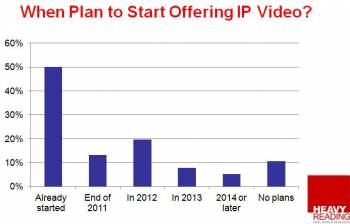Predictions 2013: Traditional TV industry needs to get faster, more efficient and more agile

Depending upon whom you talk to, 2012 was a successful, stressful, challenging and rewarding year for broadcast television stations, multichannel content providers and the manufacturing community that supports them. A number of major TV events, such as the Summer Olympics in London and the Presidential election, helped bolster broadcasters ad revenues, yet we continue to see consolidation and technical staff layoffs.
What we’ve learned from this past year is that consumers want to watch video in places other than their living room. Indeed, consumers have gained a level of control they never had before. Therefore, fast, efficient and agile might be the mantra for everyone serving them going forward.
One technology area that has really come a long way this year is the delivery of live and on-demand video across multiple display screens simultaneously. Some refer to it as over the top (OTT), TV Everywhere and video streaming, but they all basically mean the same thing. A file is sent to multiple devices, in multiple formats, over an Internet Protocol (IP) infrastructure. It’s a one-to-one (point-to-point) transfer. The concept has been talked about for several years, but 2012 saw several real-world examples of where portable video consumption and social media really proved their value.
Monetizing video streams
Yet that does not mean networks and local stations made a lot of money on it. NBC Universal provided access to more than 5500 hours of Olympics coverage, with 272 hours on the main NBC channel alone. That’s almost 2000 hours more than they offered U.S. viewers of the 2008 Beijing Olympics. It came away with a slight profit, although when you factoring in all of the operational costs, it was probably a wash (which is better than the Vancouver Winter Games, which lost an estimated $223 million for the network in 2010).

“Broadcasters have to figure out how to more effectively monetize multiscreen-delivered content, and that will be a focus of everyone in 2013,” said Sam Blackman, CEO of Portland, OR-based Elemental Technologies.
During the summer Olympics, his multiscreen services company helped broadcasters like EuroSport, CTV (Canada) and Terra Networks (Brazil) deliver 27 streams/channels at any one time to tablets, smart phones and computers.
“This year broadcasters made the first ever all-digital experience of the Olympics completely transformative,” Blackman said. “Instead of just watching a single TV channel, you could watch every event at any time, either live or on-demand. That’s very powerful for both the consumer and the media brand. We are seeing large providers like ESPN, ABC and HBO doing a great job, where some of their online properties are getting higher ad rates than they are with their traditional TV channels. It’s even higher than legacy VOD.”
What made it possible was file-based and IP file delivery architectures and workflows, which can be deployed and reconfigured relatively easily and cost-effectively. The days of SDI-HD baseband video are clearly numbered.
Karl Schubert, chief technology officer at Grass Valley, sees broadcasters and media companies around the world continuing an industry-wide migration to

file-based and IP workflows, and manufacturers supporting that initiative with an increasing amount of software and networked platforms that allow users to work collaboratively and a lot more efficiently.
“The advantage of software is that it allows us to get closer to realizing what the creatives want to do,” Schubert said. “At the end of the day, that’s what it’s all about for a technology vendor. The closer you are to hardware, the farther you are from the creative process. When we speak to customers about their creative goals, we find can show them how we can help do the same current work with less physical technology in front of them. They immediately become interested. Who wouldn't? As a company, Grass Valley is working hard to enable creativity. So, the tools do not define the task, but the other way around. That’s how we’ll keep our customers and help them migrate to the next best thing and allow them to increase their productivity and realize their business and creative objectives.”
Getting there in the next few years is a challenge that Schubert has taken on with enthusiasm and an understanding that budgets are limited in many cases, so the digital workflow transition might happen slower than some might expect. This is especially true, he said, in emerging countries like China and South America, where many broadcast and production facilities are just now being converted from standard-definition to high-definition operations.
Indeed, the coming year will be filled with significant innovations in the area of IP-based networks and packet-based global signal delivery. But, can existing wired infrastructures needed to deliver all of this video handle all of this increased IP traffic?
Video on demand, everywhere
New research from Bell Labs, the research arm of Alcatel-Lucent, predicts that increasing consumption of video content on mobile devices will push the wired broadband networks that carry this traffic to their absolute limits over the next decade. Bell Labs projections suggest that, by 2020, consumers in the United States alone will access seven hours of video each day — as opposed to 4.8 hours today, and will increasingly consume this additional video on tablets, both at home and on the go.
Significantly, the research also points to a dramatic shift in viewing habits, as consumers switch from broadcast content to video-on-demand services, which will grow to 70 percent of daily consumption, compared with 33 percent today.
The projections also suggest a 12X increase in Internet video content as cloud services, news sites and social networking applications become more video-based, and continuously accessible anywhere, anytime on tablets, smart phones and computers.
“Delivery of video from the cloud and from content delivery networks to tablets, TVs and smartphones — with guaranteed quality — presents an exciting new revenue opportunity for communications service providers,” said Marcus Weldon , Chief Technology Officer, Alcatel-Lucent, “but only if they are prepared to take advantage of it. Left unmanaged, the rapid growth in video traffic can turn into a deluge and spell disaster.”
Live and on-demand video over IP
Several manufacturers have begun to demonstrate ways to deliver a live signal over IP, which to date has been problematic (due to timing issues between multiple cameras and when, and how, they are delivered to the video production switcher prior to broadcast).
Kay Johansson, CTO with MobiTV (which has also helped broadcasters stream a number of high-profile events) said the difference between live broadcasts and video on demand over IP is that VOD can be served from a variety of sources and edge servers. When it comes to live content, there is only one point of origination.

“So, building a system that operates with minimal delays and has the highest distribution over the network is very complex,” Johansson said. “What I think many people have missed is that they don’t understand the complexity to make it work seamlessly for the end user. There is still a satellite downlink, and from that point everything has to originate out. For live broadcast served over multiple devices, you have to look at how you maximize bandwidth and peering agreements between different networks. If you want to do VOD, you try to figure out ways to cache it and store it at the edge.”
Securing content from piracy is a major issue when it comes to video consumption “everywhere.” That’s where companies like Adobe Systems, with its Adobe Pass authentication software — part of Adobe’s Project Primetime platform — come in. The new software was used to authenticate the live streaming of NBC’s Olympics coverage and, according to the company, Adobe Pass is now supporting more than 40 sites and mobile apps from 25 top programmers. It’s also integrated with more than 150 cable and satellite operators, enabling TV content across devices from Fox, ESPN, CNN, TNT, MTV, Disney and NBC Olympics.
“As multi-platform video consumption continues to grow rapidly, content providers have to be able to reach audiences and deliver seamless authentication experiences to ensure TV-level scale across all major platforms and device types,” said Pritham Shetty, vice president, Product Management and Engineering, Video Solutions, at Adobe. “ By working closely with our broadcast partners and introducing new innovations in Adobe Pass, Adobe is removing major adoption barriers and making the use of TV Everywhere incredibly easy for consumers.”
Channel-in-A-box
At the local station level, products like channel-in-a-box servers are helping launch new channels online and elsewhere while limiting the need for Master Control operators. It’s not happening everywhere, but independent station groups (indeed, all broadcasters) are continuing to look for new ways to limit operational expenses. These devices offer master control automation, branding, graphics and video server capability in one affordable, software-based, 1RU platform.
SOAs
At the higher end, service oriented architectures (SOAs) have begun to be implemented in larger multichannel facilities that allow many people involved with content creation and delivery to allow work collaboratively with the same interface connected via a fully redundant storage area network. This improves speed and productivity and, it’s been said, brings the staff together in ways that took a lot more effort previously. But it’s not so easy to do.
“I think a lot of people don't realize that deploying a SOA takes careful planning and a lot of customization work,” said Jimm Popowytsch, Vice President of Engineering and IT, AMC Networks Broadcasting & Technology.
Located in Bethpage, NY, the company operates a state-of-the-art technical facility that consolidates origination and satellite communications functions in one 62,000sq-ft facility and helps AMC Networks maintain both standard- and high-definition digital infrastructures.
“Everybody’s view of what an SOA should look like is going to be different, and that includes the manufacturers of this technology,” Popowytsch said. “If I’m talking to a Rhozet Carbon server, a QC device, there’s so many little things that you have to deal with in order to make it work.”
To this end, Grass Valley’s Schubert said his company is focused on bringing the same flexibility that virtualization has brought to the IT world. He refers to it as an “abstracted infrastructure,” whereby the user does not care where their video server, or router, or video switcher is located, as long as they have access to the content.
“If you are able to run that function anywhere in your network,” Schubert continues, “You now have an enormous amount of flexibility. The infrastructure [physical systems] shouldn't be the thing that is stopping you from doing the work you need to accomplish.”
With 2012 now in the books, the traditional television industry will be looking ahead in 2013 to staying competitive in the areas of mobile video, multiscreen and even digital subchannel delivery. It remains to be seen whether that can be accomplished.
Editor’s Note: It’s always amusing (to me, anyway) to look at some predictions and see how stood the test of time. Here’s one: In 2008, Cisco Systems said that by 2013, annual global IP traffic would reach two-thirds of a zettabyte (that’s a trillion gigabytes). Cisco also forecasted that 90 percent of consumer IP traffic (which makes up the majority of total IP traffic) would be video in 2013 and that video consumption on mobile devices would reach 64 percent of total mobile IP traffic by 2013. We now know that these numbers were (and still are) a bit optimistic. Currently, according to Cisco research, video streaming represents 56 percent of all IP bandwidth usage.
Get the TV Tech Newsletter
The professional video industry's #1 source for news, trends and product and tech information. Sign up below.
